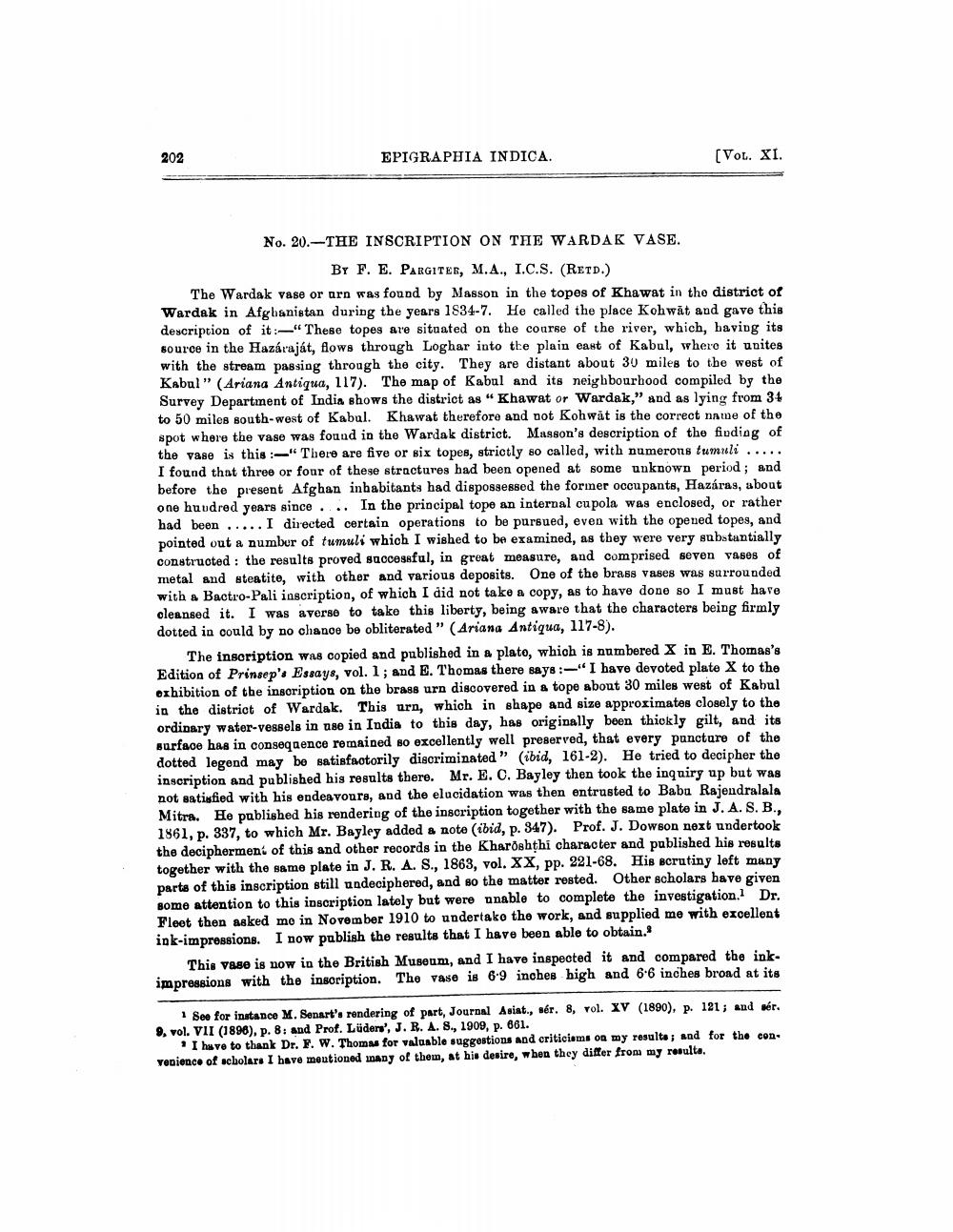________________
202
EPIGRAPHIA INDICA.
(Vol. XI.
No. 20.-THE INSCRIPTION ON THE WARDAK VASE.
BY F. E. PARGITER, M.A., I.C.S. (RETD.) The Wardak vase or arn was found by Masson in the topes of Khawat in the district of Wardak in Afghanistan during the years 1834-7. He called the place Kohwät and gave this description of it:-" Thebe topes are situated on the course of the river, which, having its source in the Hazáraját, flows through Loghar into the plain east of Kabul, where it unites with the stream passing through the city. They are distant about 30 miles to the west of Kabul" (Ariana Antiqua, 117). The map of Kabul and its neighbourhood compiled by the Survey Department of India shows the district as "Khawat or Wardak," and as lying from 3+ to 50 miles south-west of Kabul. Khawat therefore and not Kohwat is the correct name of the spot where the vase was found in the Wardak district. Masson's description of the finding of the vase is this :-" There are five or six topes, strictly so called, with numerons tumuli ..... I found that three or four of these stractures had been opened at some unknown period; and before the present Afghan inhabitants had dispossessed the former occupants, Hazáras, about one huudred years since ... In the principal tope an internal cupola was enclosed, or rather had been ..... I directed certain operations to be pursued, even with the opened topes, and pointed out a numbur of tumuli which I wished to be examined, as they were very substantially constructed: the results proved successful, in great measure, and comprised seven vases of metal and steatite, with other and various deposits. One of the brass Vases was surrounded with a Bactro-Pali inscription, of which I did not take a copy, as to have done so I must have cleansed it. I was averse to take this liberty, being aware that the characters being firmly dotted in could by no chanoe be obliterated" (Ariana Antiqua, 117-8).
The inscription was copied and published in a plato, which is numbered X in E. Thomas's Edition of Prinsep's Essays, vol. 1; and E. Thomas there says :-"I have devoted plate X to the exhibition of the inscription on the brass urn discovered in a tope about 30 miles west of Kabul in the district of Wardak. This urn, which in shape and size approximates closely to the ordinary water-vessels in use in India to this day, has originally been thickly gilt, and its surface has in consequence remained so excellently well preserved, that every pancture of the dotted legend may be satisfactorily discriminated ” (ibid, 161-2). He tried to decipher the inscription and published his results there. Mr. E. C. Bayley then took the inquiry up but was not satisfied with his endeavours, and the elucidation was then entrusted to Baba Rajendralala Mitra. He published his rendering of the inscription together with the same plate in J. A. S. B., 1861, p. 337, to which Mr. Bayley added a note (ibid, p. 347). Prof. J. Dowson next undertook the decipherment of this and other records in the Kharoshthi character and published his results together with the same plate in J. R. A. S., 1863, vol. XX, pp. 221-68. His scrutiny left many parts of this inscription still undeciphered, and so the matter rested. Other scholars have given some attention to this inscription lately but were unable to complete the investigation. Dr. Fleet then asked me in November 1910 to undertako the work, and supplied me with excellent ink-impressions. I now publish the results that I have been able to obtain.
This vase is now in the British Museum, and I have inspected it and compared the ink. impressions with the inscription. The vase is 6.9 inches high and 6.6 inches broad at its
1 See for instance M. Senart's rendering of part, Journal Asiat., sér. 8, vol. XV (1890), p. 121; and sér. 9, vol. VII (1896), p. 8: and Prof. Lüders', J. R. A. 8., 1909, p. 661.
I have to thank Dr. F. W. Thom for valuable suggestions and criticisms on my resulta; and for the convenience of scbolars I have meutioned many of them, at his desire, when they differ from my results.




